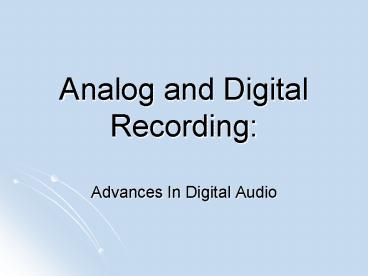Analog and Digital Recording: - PowerPoint PPT Presentation
1 / 19
Title: Analog and Digital Recording:
1
Analog and Digital Recording
- Advances In Digital Audio
2
The Human Ear
- The human ear hears sound through rapid
variations in air pressure (Keating 02). - This can be referred to as analog sound (Gateway
3).
3
Earlier forms of Recording
- Edisons phonograph, invented in 1877 was one of
the first ways of recording analog sound This
process involved a sharp needle etching grooves
onto foil cylinder (Gateway 4). - Before the advent of digital recording, analog
recordings could also be done via reel to reel
machines. This technology involved using magnetic
tape and tape heads to read the variations in
sound (Sweeney 5).
4
Digital Audio
- Digital audio is represented using binary code
(1s and 0s) to reproduce the audio frequencies
(Hass). - The sound waves are reproduced by sampling
Sampling is the times per second a sound wave is
measured (Keating 7).
5
What's wrong with Analog?
- Recording audio with analog equipment cannot
reproduce sound with absolute precision (Gateway
5). - In certain instances, editing capabilities in
reel to reel machines are hindered by having to
physically cut the tape, splicing (Keating 7). - When re-recording over top an existing recording,
the quality of the tape is degraded (Gateway 5).
6
What's wrong with Analog?
- Playback on analog machines introduces extra
noise (wow and flutter, tape hiss) (Gateway 5). - When making copies of a copy, quality is reduced
in each copy (Gateway 5). - Most analog tape recorders can only record 8
tracks at a time, sometimes less. - Professional grade analog recording equipment is
very costly compared to digital.
7
What's right with Digital Recording?
- When recorded at a high sampling rate and bit
resolution, digital recording is far more
accurate than analog, primarily due to analog
recording having a low signal to noise ratio
(Gateway 8). - Signal to noise ratio is far superior to analog
(Keating 7). - No loss in coping copies. Copying digital
information is copying bits, where as analog
stores information on grooves of a record or on a
magnetic tape (Gateway 8).
8
Whats right with Digital recording, continued.
- Editing capabilities are in most cases,
limitless. - Purchasing digital audio recording equipment is
getting cheaper and cheaper. - Messing up and needing to record something over
does not degrade tape or disc, like it does with
analog tape (Gateway 8).
9
Its hard to find anything wrong with digital
audio recording!But, to be as objective as
possible
10
One conceivable advantage analog has over digital
recording is
- When levels run hot, or in the red, on a analog
recording, there is a forgiving threshold of
headroom before the recording sounds distorted
(Keating 3). - In most cases this is a highly desired sound.
- When a digital recording is faced with hot
levels, the sound of digital distortion is very
unappealing. The sound must be remedied by
adjusting the level to where there is no clipping.
11
Digital Options
- When deciding on what type of digital recording
equipment to buy there are several things to
consider. - Budget
- Size of recording room
- Whether to record using a computer or a stand
alone Digital Audio Workstation or DAW. - MIDI?
12
Budget
- Many exciting options are available for all
budgets. Check online at - www.musiciansfriend.com
- www.americanmusical.com
- Advances in technology have made it easier to
make good quality recordings on even a limit
budget.
13
Size
- Overall size of your recording production
- How many microphones/instruments to record at
once. - How many inputs you will need.
- How many outputs you will need.
- If you will be tracking, or if you want to master
(finalize) you recording.
14
MIDI?
- Whether or not you will be MIDI applications.
MIDI stands for Musical Instrument Digital
Interface(Keating11). - MIDI is a way of digital instruments, i.e.
keyboards, to communicate with each other. - MIDI is also used to sequence other MIDI devices
together. - If you are interested in using several keyboards
and/or sequencers you may want to look into a
recorder with MIDI capabilities.
15
Tracking Options
- You can decide to do you tracking with a
computer. For tracking on computers you will need
at least a soundcard, tracking program and a
mixer. - Or you can use a DAW. DAW are essentially a mixer
with a computer inside them. Some also come with
CD-R/RWs built into them.
16
Specifications Of digital.
- The most common method of creating digital audio
is Pulse-code modulation (PCM). PCM digital audio
is typically sampled at 44.1 kHz (for CD
recordings) or 48 kHz (for professional audio
applications). For comparison, speech signals for
telephony are only sampled at 8 kHz. Higher
sample rates for professional recording are
becoming popular. These include 88.2 kHz, 96 kHz,
and 192 kHz (Wikipedia).
17
Conclusion
- Whether or not your mind is made up, it is
obvious to all that digital recording is the way
of the future and beyond. - You have many options and help resources assist
everyone from the beginner to the novice.
18
Bibliography
- Sweeney, Daniel. Demystifying Compact Disc A
Guide to Digital Audio. Blue Ridge SummitTBI,
1986. - Keating, Carolyn, ed. Digital Home Recording.
Technical Ed Craig Anderton. San FranciscoBB,
1998. - Use Your PC to Explore Digital Music. Poway
Gateway Inc., 2002. - Hass, Jeffery. Principals of Digital Audio. 27
Jan. 2005 lthttp//www.indiana.edu/emusic/digital_
audio.htmlgt. - Digital Audio. 27 Jan. 2005 lthttp//en.wikipedia.o
rg/wiki/Digital_audiogt. - Brain, Marshall. How Analog and Digital Recording
Works. 27 Jan. 2005 lthttp//stuffo.howstuffworks.c
om/analog-digital1.htmgt.
19
Thank You
- for watching.































